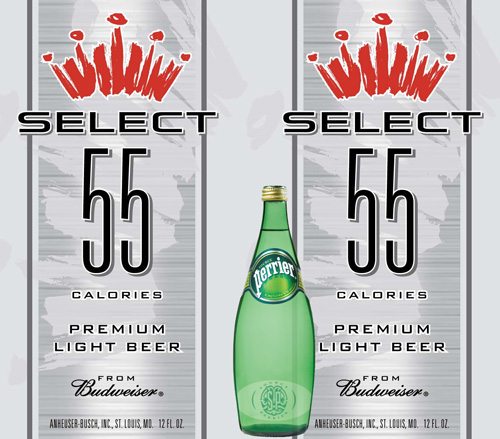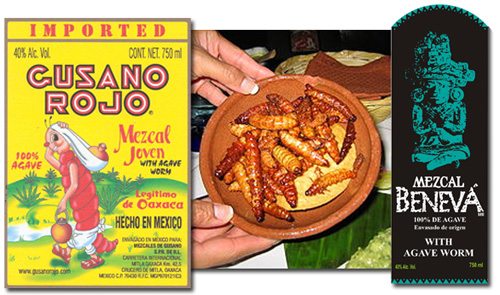First there was Miller Lite, at about 96 calories per 12 ounces (back around 1975). In later years the non-alcoholic malt beverages (or “near beers”) became more common, with leading brands such as Clausthaler and Kaliber at about 80 calories (as per Skilnik). Now, in the past year, it appears we have a race to the bottom. That is, Miller Genuine Draft 64 came out about a year ago. It is, not surprisingly, 64 calories per 12 ounces (and 2.8% alc./vol.). Lower and more recent still is Bud Select 55. It is only 55 calories and 2.4% alc./vol. This is one important trend over the past 34 years. In a future post we will look at a countervailing trend toward very high calorie/alcohol malt beverages. All of this leads us to wonder, where will this go in the next 34 years? When the Jonas Brothers hit middle age, will they be drinking Bud Exträ Epic Mega Select 11 (down near the lower limits for the legal definition of beer)? Hops flavored Perrier?
Continue Reading Leave a Commentwould you drink it?
Miller and Bud Race Yet Again

Tags: brand extensions, business strategy, serving facts/allergens, would you drink it?
Meaty Booze 4, Bugs

Let’s make it four in a row. Spirits with something close to meat. First we had worms, scorpions and chicken. We’ll stop before getting to snake. But today is an insect, widely used in spirits. The bug to the left is a cochineal beetle (Dactylopius coccus) and it is widely used in the food industry to make a natural red color called carmine. Wiki says: “The insect produces carminic acid that deters predation by other insects. Carminic acid can be extracted from the insect’s body and eggs to make carmine dye (also known as cochineal). Carmine is primarily used as a food colouring and for cosmetics.” We certainly don’t mean to imply that there is anything wrong with this color; it’s been used for centuries and is an alternative to synthetics. This 1999 Campari approval shows the carmine on the back label. This 2007 Smirnoff approval also shows carmine on the back label. FDA has recently called for clear disclosure of this color.
July 9, 2009 Update. Campari has helpfully explained: “Campari ceased using carmine in the vast majority of its worldwide production (including the US) in 2006.”
Continue Reading Leave a CommentTags: ingredients, would you drink it?
Meaty Booze 3, Chicken

OK we admit that the aforementioned spirits with worms and scorpions are a little light on meat. But here is the real thing. Spirits with chicken. Chicken. It is commonly known as Pechuga. Del Maguey is a famous brand. The producer warns about plenty of fake mezcal and pechuga and explains:
Continue Reading Leave a CommentPechuga is begun with Minero; mezcal that has already been double distilled. In preparation for a third distillation [the producer adds] wild mountain apples and plums, big red plantain bananas, pineapples, a handful of almonds and a few pounds of uncooked white rice. Next, a whole chicken breast, skin removed, bone structure complete, is washed in running water for about three hours to remove any grease. This is then suspended by strings in the atmosphere of the still and a 24 hour, third distillation is begun. The vapor passes over the pechuga and condenses into a crystal clear liquid that has an amazing taste and smoothness. The reason for the breast they say, is so the mezcal is not dominated by the fruit…a balance. Upon completion the Pechuga is removed from the still and hung in the family Altar room…the most important space in the house.
Tags: ingredients, would you drink it?
Meaty Booze 2, Scorpion

On Monday we showed a couple of spirits products containing meat, in the form of Mezcal worms. Today we have a variation, Mezcal with a scorpion. Scorpion is the main brand in this category. The importer explains that all varieties of Scorpion Mezcal come with a real scorpion in the bottle:
Continue Reading Leave a CommentIs the scorpion harmful or poisonous? No, the scorpion is not harmful or poisonous. The stinger has been removed. In fact, this product has been FDA approved! … We do not recommend eating the scorpion but if consumed please chew it up adequately before swallowing. Does the scorpion change the flavor of the Mezcal? No, the full smooth flavor is retained and the scorpion imparts no flavor. The scorpion novelty is successful for gift markets and creates immediate interest in the product.
Tags: ingredients, would you drink it?
Meaty Booze 1, Worm

Most people expect fruit and vegetable matter in their spirits. Less commonly, they expect — meat. And yet it’s not so very rare. The most obvious “meat,” in common use, is the lowly worm that’s been sitting at the bottom of your Mezcal bottle for many years. Gusano Rojo Mezcal is a good example, because the label has a nice little picture of the worm. Mezcal Beneva is a second example. The Beverage Tasting Institute explains:
The famous “worm” that is found in some bottles of Mezcal (con gusano — “with worm”) is actually the larva of one of two moths that live on the agave plant. The reason for adding the worm to the bottle of Mezcal is obscure. But one story, that at least has the appeal of logic to back it up, is that the worm serves as proof of high proof, which is to say that if the worm remains intact in the bottle, the percentage of alcohol in the spirit is high enough to preserve the pickled worm. Consuming the worm, which can be done without harm, has served as a rite of passage for generations of fraternity boys.
We’ll deliver more meat in a day or two.
Continue Reading Leave a CommentTags: ingredients, would you drink it?
Real or Fake?

Would anyone expect this to be a big seller in the US? In Macedonia? It’s not clear why it ought to be considered “diluted,” since it meets the 80 proof threshold required for regular brandy. For the answer, click the label.
[polldaddy poll=1475234]
Continue Reading Leave a CommentTags: type, would you drink it?

